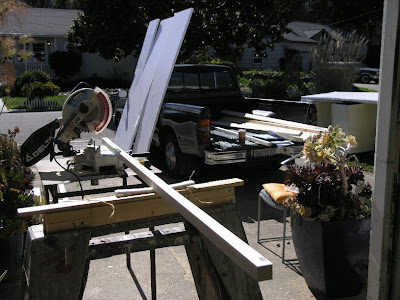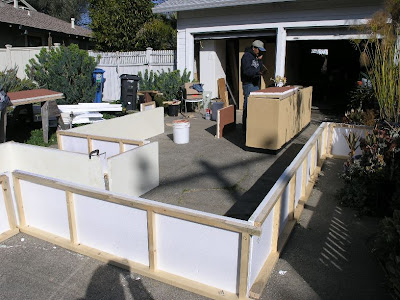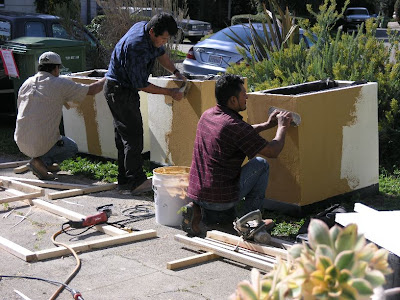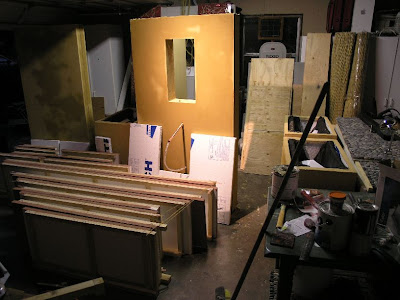I think that we are in pretty good shape in regards to the prefabrication of the project.
As of today we have all the American Clay applied to the planter boxes and walls.
I spend three full days last week cutting the wood frames, the 1.5 inch thick styrofoam , prime painting and assembling the perimeter planting boxes.



The guys came after all the boxes were assembled and applied the American Clay

I’m not so thrilled with the Colorado Red color of the American Clay
It has dried too light and “pinkish” G A S P ! No NOT PINK !
So I have to figure out a way to darken the color either by applying a wax or oil type finish or do another coat with more iron oxide pigment mixed into the clay.

But for this evening, the bulk of the pre-fabrication is almost done , with the exception of the cast concrete stepping stones.
All the pieces are now drying, curing and resting until the big move out.








5 comments:
Question: Are the planters being made of styrofoam for ease of transport and portability? I was wondering if they would be suitable for permanent display?
I'm not an expert on building materials but a while back I was at my local Transit Center and noticed that the moulding on the seating structures http://www.ci.pomona.ca.us/kiosk/images/transit_center.jpg looked to be made from fiberglass and styrofoam. I noticed what it was made from because it looked like a kid or somebody was standing on the seat and broke a piece off and I could see the inside beneath the stucco. Since that is a permanent structure I would assume whoever designed it found that the material possesed long term viability. Do you know of any permanent installations that use a similar material and still looks good aesthetically? I'm considering making some planters of my own out of the same materials as an alternative to massive,rather heavy, expensive ones. What do you think?
The picture on that link is kind of small. Theres a better one here.
http://www.ci.pomona.ca.us/uploaded_images/METROpomona_downtown.jpeg
When I had a similar color problem a few years ago with a concrete fountain in the NJ show, I bought a range of pastels and some fixative. I rubbed the surface with a variety of colors--didn't use the fixative. That fountain base still has the color 3 years later. Cheap and easy.
Are you concerned about the styrofoam denting in transport--even with the plaster finish?
Also I said I'd report back on the bio wall at our show. Plug trays. 32s and 50s. The cells held the plants even though the roots weren't fully developed.
You're in great shape.
Hi Garrett,
Yes, the planter are crafted from styrofoam for ease of transport.
The 'garden stage set' that we're making could stand up to the elements if they were build studier and clad with real stucco .
Basically these American garden shows are nothing more than a big stage set , unlike many of the British and European garden shows which are built like a real garden over a period of months and are outdoors.
We have three days to set them up in an big arena and they are viewed by the public for 5 days.
In the S.F. garden show case, approximately 55 thousand people will view the gardens during those 5 days.
I'm not an expert either on building materials but I am very familiar with the EIFS ( exterior insulating finishing system ) building technique that you described.
It is becoming a commonly used system in commercial architecture and in track housing developments.
It is extremely easy to work with which makes it a good building material for unskilled and skilled workers alike to install.
To see rows and rows of houses made with this stuff all you have to do is drive through a track housing development where the houses are stucco'ed.
It is actually not real stucco on those houses but an acrylic type matrix ( Dryvit is the most common here in California ) that is either sprayed or troweled over a styrofoam insulating base.
They make an incredible array of non-structural architectural details out of this stuff, things like corbels, dentil work , columns, window sills , door jambs, rail tops and more.
With the proper type of water proofing you can easily make light weight planters with the stuff but it is not a product that stands up to abuse, such as shovels accidently hitting the corners or a wheel barrow falling against a planter that is loaded with gravel or soil.
Some EIFS are more durable than other systems, but all use the styrofoam like substructure which makes you have to really think hard whether or not it is a good choice for your application.
Hi Susan,
I'm not concerned about the styrofoam denting too much.
I have a bucket of mud and some patch materials ready to go if a dent does arise.
I am going to try a couple of different color enhancing techniques on a extra piece of clay covered styrofoam.
There is something called 'black soap' that is recommended as a natural color darkener on this product.
I also know that plain old cooking oil will darken the clay... just don't want it to start smelling rancid during the show !
Thanks on the bio wall info.
I think I jumped the gun a little bit on scrubbing the whole thing.
The weather has been extremely warm in this last past 3 and a half weeks and it is amazing the amount of root growth that has taken hold during that time !
I think if I waited a little bit longer I could have made it a 'go'.
Impatience and nerves got the best of me on that one !
Off to Sonoma for the day to verify the status of the furniture and Balinese stone planters from my supplier.
have a good day all .
michelle
Yeah, I thought about the durability...It seems to me that it's used in more above head applications where accidents arn't all that common.
I've learned something new from you everyday since I started reading your blog!
Post a Comment